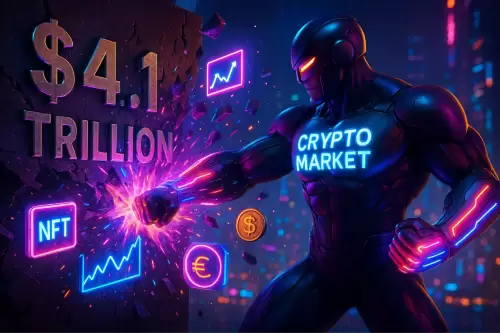 |
|
 |
|
 |
|
 |
|
 |
|
 |
|
 |
|
 |
|
 |
|
 |
|
 |
|
 |
|
 |
|
 |
|
 |
|
Cryptocurrency News Articles
Bitcoin Futures Have Become a Key Player Linking Traditional Finance with Digital Assets
May 16, 2025 at 09:04 pm
Bitcoin futures have become a key player linking traditional finance with digital assets, and the shift is pretty striking. While the world of blockchain

The introduction of Bitcoin futures has been a pivotal moment in linking traditional finance with the burgeoning world of digital assets. While the narrative of blockchain often centers around decentralization, the maturation of Bitcoin futures is a tale of institutions engaging with a new asset class in a massively scaled manner.
The second half of 2025 has seen a striking convergence of forces. Some regulated exchanges began offering 24/7 trading of both Bitcoin and Ethereum futures, a testament to the increasing demand for liquidity and access within compliant structures.
The involvement of major financial players has also been critical. As we discussed in previous articles, traditional institutions are showing a keen interest in digital asset derivatives. The 24-hour access to BTC futures on regulated platforms is a sign of this shift.
This evolution is forcing large investors to adjust their risk management strategies and exposure in interesting ways. We’ve seen a strong inflow of institutional capital into digital assets in early 2025, catalyzed by the availability of futures, ETFs, and, crucially, regulatory frameworks.
The first quarter saw a massive influx of capital into Bitcoin ETFs as major financial firms integrated digital assets into their portfolios. This participation from large institutional investors, who typically employ sophisticated futures trading strategies, will be crucial in determining how the market develops in the coming year.
The fact that investors are placing a large percentage of their asset allocations into digital assets by 2025 is a sign of the confidence in cryptocurrencies as a distinct asset class, offering the potential for greater return and better portfolio diversification.
Bitcoin futures provide traders with exposure to the price movements of Bitcoin without requiring them to hold the underlying asset, enabling the construction of complex trading strategies.
Those who trade Bitcoin futures are not limited to simply taking long or short positions on the cryptocurrency; rather, they engage in sophisticated tactics typically employed by institutions and experienced traders to create complex portfolio structures and manage risk effectively.
Their strategies usually involve maintaining multiple positions across different markets and time frames. For example, a trader might buy a spot position on Bitcoin while simultaneously selling a futures contract, effectively hedging against potential price drops.
These strategies allow participants to lock in prices or hedge directional risk effectively, especially in a market that experiences significant volatility. Today, mastering these tools is fundamental to succeeding in the market.
One core strategy traders use is basis trading in Bitcoin futures. This approach attempts to capitalize on the price differential between the futures contract and the spot market, known as the basis. The basis can be either positive, in contango, or negative, in backwardation.
Traders engaging in basis trades typically buy Bitcoin in the spot market while simultaneously selling a related futures contract. As the futures contract's price converges with the spot price around the time of expiration, the trader aims to profit from the initial price discrepancy.
This is a principled market-neutral strategy, best executed profitably at scale with the sort of capital and knowledge of market structure that institutional participants possess in 2025.
The data generated by Bitcoin futures markets is also valuable, with key metrics including trading volume, open interest, and funding rates being closely monitored by analysts to assess market sentiment and predict possible price moves.
High trade volumes are usually correlated with sustained price trends, indicating strong market conviction behind the move. Open interest, the total number of active futures contracts, typically increases with increased price trends and capital flowing into the market or decreases with price trends exhausting themselves and capital exiting the market.
Finally, funding rates for perpetual futures provide an indication of where the market's collective interest lies. If the funding rate is really high, then many traders are paying cash to keep their long positions.
The persistent buying pressure from institutional investors over the last year has been a strong factor in the 2025 bull market. But if the market is pivoting to a bearish trend, we might expect to see more traders short the market and collect the funding payments.
For the futures market, open interest provides a measure of the depth of the market and is defined as the total number of outstanding active contracts at any given time. Major increases in open interest usually accompany major price movements and indicate that the trend is being backed by fresh capital.
Conversely, a decrease in open interest during a price move might indicate liquidation or the closing of positions and could be a sign that a trend is slowing. Using the standard CME Group data, we can see that the open interest for both Bitcoin and Micro Bitcoin futures is fairly high, even in Q1 2025.
This shows just how much money is tied up in these contracts and how institutions are managing their Bitcoin investments through derivatives.
As we all know, Bitcoin is famous for its price volatility. To manage this inherent characteristic of the market, futures contracts provide traders with valuable tools and strategies.
Hedging strategies using futures can protect investors from the loss of trading profits due to adverse price swings in their spot holdings
Disclaimer:info@kdj.com
The information provided is not trading advice. kdj.com does not assume any responsibility for any investments made based on the information provided in this article. Cryptocurrencies are highly volatile and it is highly recommended that you invest with caution after thorough research!
If you believe that the content used on this website infringes your copyright, please contact us immediately (info@kdj.com) and we will delete it promptly.






























































